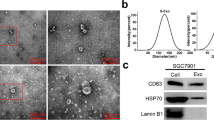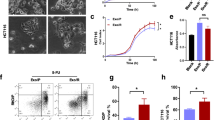Abstract
Our previous study shows that high Chloride intracellular channel 1 (CLIC1) expression can efficiently enhance invasion and migration of gastric cancer (GC) cells in vitro. Growing evidences have found that exosomes are involved in chemotherapy resistance in several cancers including GC. We aimed to evaluate the effect of the exosome-mediated transfer of CLIC1 in the vincristine-resistance of GC. The effect of exosome-mediated transfer of CLIC1 on the development of resistance to vincristine in GC cell line SGC-7901 and the potential underlying mechanisms were investigated by Cell Counting Kit-8 (CCK8), RT-PCR, and Western blotting. Exosomes were isolated from cell supernatants by differential ultracentrifugation. Comparing with SGC-7901, the expression level of CLIC1 is higher in vincristine‑resistant cell line SGC-7901/VCR (P < 0.05). After silencing the expression of CLIC1 by RNA interference, the half inhibition concentration (IC50) to vincristine decreased significantly in SGC-7901/VCR, and the expression of CLIC1 decreased significantly in exosomes from SGC-7901/VCR. After 48 h co-culturing with exosomes from SGC-7901/VCR, the IC50 to vincristine in SGC-7901 increased significantly, and the expression of CLIC1, P-gp, and Bcl-2 were significantly up-regulated. CLIC1 was closely associated with the resistance to vincristine in GC, and exosome-mediated transfer of CLIC1 could induce the development of resistance to vincristine in vitro. The possible mechanism was related to up-regulated P-gp and Bcl-2. However, in vivo study was needed to confirm the results in future.





Similar content being viewed by others
References
Siegel RL, Miller KD, Jemal A (2015) Cancer statistics, 2015. CA Cancer J Clin 65(1):5–29
Yu S, Yang CS, Li J, You W, Chen J, Cao Y, Dong Z, Qiao Y (2015) Cancer prevention research in China. Cancer Prev Res (Phila) 8(8):662–674
Wagner AD, Syn NL, Moehler M, Grothe W, Yong WP, Tai B-C, Ho J, Unverzagt S (2017) Chemotherapy for advanced gastric cancer. Cochrane Database Syst Rev 8:CD004064
Gillet JP, Gottesman MM (2012) Overcoming multidrug resistance in cancer: 35 years after the discovery of ABCB1. Drug Resist Updat 15(1–2):2–4
Dehghan-Nayeri N, Eshghi P, Pour KG, Rezaei-Tavirani M, Omrani MD, Gharehbaghian A (2017) Differential expression pattern of protein markers for predicting chemosensitivity of dexamethasone-based chemotherapy of B cell acute lymphoblastic leukemia. Cancer Chemother Pharmacol 80(1):177–185
Peretti M, Angelini M, Savalli N, Florio T, Yuspa SH (1848) Mazzanti M (2015) Chloride channels in cancer: focus on chloride intracellular channel 1 and 4 (CLIC1 AND CLIC4) proteins in tumor development and as novel therapeutic targets. Biochim Biophys Acta 10 Pt B:2523–2531
He Y, Zhang Z, Liu Q, Xiao Y, Wei L, Xi C, Nan X (2018) Effect of CLIC1 gene silencing on proliferation, migration, invasion and apoptosis of human gallbladder cancer cells. J Cell Mol Med 22(5):2569–2579
Lu J, Dong Q, Zhang B, Wang X, Ye B, Zhang F, Song X, Gao G, Mu J, Wang Z, Ma F, Gu J (2015) Chloride intracellular channel 1 (CLIC1) is activated and functions as an oncogene in pancreatic cancer. Med Oncol 32(6):616
Zhang J, Li M, Song M, Chen W, Mao J, Song L, Wei Y, Huang Y, Tang J (2015) CLIC1 plays a role in mouse hepatocarcinoma via modulating Annexin A7 and Gelsolin in vitro and in vivo. Biomed Pharmacother 69:416–419
Wang P, Zeng Y, Liu T, Zhang C, Yu P, Hao Y, Luo H, Liu G (2014) Chloride intracellular channel 1 regulates colon cancer cell migration and invasion through ROS/ERK pathway. World J Gastroenterol 20(8):2071–2078
Singha B, Harper SL, Goldman AR, Bitler BG, Aird KM, Borowsky ME, Cadungog MG, Liu Q, Zhang R, Jean S, Drapkin R, Speicher DW (2018) CLIC1 and CLIC4 complement CA125 as a diagnostic biomarker panel for all subtypes of epithelial ovarian cancer. Sci Rep 8(1):14725
Wu J, Wang D (2017) CLIC1 Induces Drug Resistance in Human Choriocarcinoma Through Positive Regulation of MRP1. Oncol Res 25(6):863–871
Zhao W, Lu M, Zhang Q (2015) Chloride intracellular channel 1 regulates migration and invasion in gastric cancer by triggering the ROS-mediated p38 MAPK signaling pathway. Mol Med Rep 12(6):8041–8047
Ma P, Chen J, Wang Z, Liu J, Li B (2012) Function of chloride intracellular channel 1 in gastric cancer cells. World J Gastroenterol 18(24):3070–3080
Valadi H, Ekström K, Bossios A, Sjöstrand M, Lee JJ, Lötvall JO (2007) Exosome-mediated transfer of mRNAs and microRNAs is a novel mechanism of genetic exchange between cells. Nat Cell Biol 9(6):654–659
Regev-Rudzki N, Wilson DW, Carvalho TG, Sisquella X, Coleman BM, Rug M, Bursac D, Angrisano F, Gee M, Hill AF, Baum J, Cowman AF (2013) Cell-cell communication between malaria-infected red blood cells via exosome-like vesicles. Cell 153(5):1120–1133
Setti M, Osti D, Richichi C, Ortensi B, Del Bene M, Fornasari L, Beznoussenko G, Mironov A, Rappa G, Cuomo A, Faretta M, Bonaldi T, Lorico A, Pelicci G (2015) Extracellular vesicle-mediated transfer of CLIC1 protein is a novel mechanism for the regulation of glioblastoma growth. Oncotarget 6(31):31413–31427
Zhang H, Jiang L, Hou J, Zhong S, Zhu LP, Wang DD, Zhou S, Yang SJ, Wang JY, Zhang Q, Xu HZ, Zhao JH, Ji ZL, Tang J (2018) Exosome: a novel mediator in drug resistance of cancer cells. Epigenomics 10(11):1499–1509
Li B, Mao Y, Wang Z, Chen Y, Wang Y, Zhai C, Shi B, Liu S, Liu J, Chen J (2018) CLIC1 promotes the progression of gastric cancer by regulating the MAPK/AKT pathways. Cell Physiol Biochem 46(3):907–924
Whiteside TL (2017) The effect of tumor-derived exosomes on immune regulation and cancer immunotherapy. Future Oncol 13(28):2583–2592
Whiteside TL (2017) Exosomes carrying immunoinhibitory proteins and their role in cancer. Clin Exp Immunol 189(3):259–267
Batrakova EV, Kim MS (2016) Development and regulation of exosome-based therapy products. Wiley Interdiscip Rev 8(5):744–757
Zhang Y, Li M, Hu C (2018) Exosomal transfer of miR-214 mediates gefitinib resistance in non-small cell lung cancer. Biochem Biophys Res Commun 507(1–4):457–464
Emam SE, Ando H, Lila ASA, Shimizu T, Okuhira K, Ishima Y, Mahdy MA, Ghazy F-ES, Sagawa I, Ishida T (2018) Liposome co-incubation with cancer cells secreted exosomes (extracellular vesicles) with different proteins expressions and different uptake pathways. Sci Rep 8(1):14493
Huang Z, Zhang S, Shen Y, Liu W, Long J, Zhou S (2016) Influence of MDR1 methylation on the curative effect of interventional embolism chemotherapy for cervical cancer. Ther Clin Risk Manage 12:217–223
Reed JC, Miyashita T, Takayama S, Wang HG, Sato T, Krajewski S, Aimé-Sempé C, Bodrug S, Kitada S, Hanada M (1996) BCL-2 family proteins: regulators of cell death involved in the pathogenesis of cancer and resistance to therapy. J Cell Biochem 60(1):23–32
Liu Y, Wang Z, Li M, Ye Y, Xu Y, Zhang Y, Yuan R, Jin Y, Hao Y, Jiang L, Hu Y, Chen S, Liu F, Zhang Y, Wu W, Liu Y (2017) Chloride intracellular channel 1 regulates the antineoplastic effects of metformin in gallbladder cancer cells. Cancer Sci 108(6):1240–1252
Qiao L, Wong BCY (2009) Targeting apoptosis as an approach for gastrointestinal cancer therapy. Drug Resist Updat 12(3):55–64
Pfeffer CM, Singh ATK (2018) Apoptosis: a target for anticancer therapy. Int J Mol Sci 19(2):448
Funding
This manuscript was supported by Natural Science Foundation of Guangxi (2018GXNSFBA281159), Youth Foundation of Guangxi Medical University (GXMUYSF201506), and Youth Teacher Foundation of Guangxi Education Department (2017KY0110).
Author information
Authors and Affiliations
Corresponding authors
Ethics declarations
Conflict of interest
The authors have no conflict of interest to declare.
Ethical approval
No animals or human participants were involved in this study.
Additional information
Publisher's Note
Springer Nature remains neutral with regard to jurisdictional claims in published maps and institutional affiliations.
Rights and permissions
About this article
Cite this article
Zhao, K., Wang, Z., Li, X. et al. Exosome-mediated transfer of CLIC1 contributes to the vincristine-resistance in gastric cancer. Mol Cell Biochem 462, 97–105 (2019). https://doi.org/10.1007/s11010-019-03613-9
Received:
Accepted:
Published:
Issue Date:
DOI: https://doi.org/10.1007/s11010-019-03613-9




